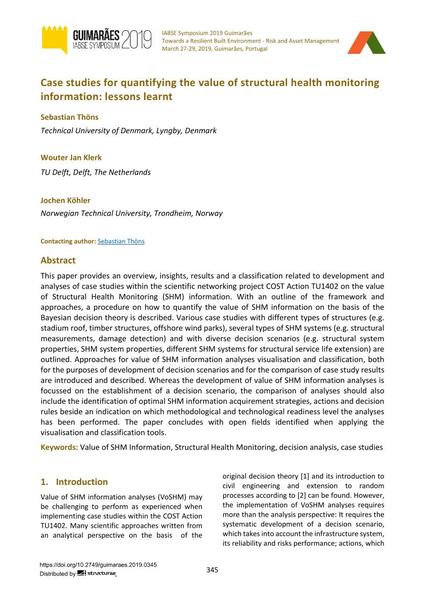Case studies for quantifying the value of structural health monitoring information: lessons learnt

|
|
|||||||||||
Détails bibliographiques
| Auteur(s): |
Sebastian Thöns
(Technical University of Denmark, Lyngby, Denmark)
Wouter Jan Klerk (TU Delft, Delft, The Netherlands) Jochen Köhler (Norwegian Technical University, Trondheim, Norway) |
||||
|---|---|---|---|---|---|
| Médium: | papier de conférence | ||||
| Langue(s): | anglais | ||||
| Conférence: | IABSE Symposium: Towards a Resilient Built Environment Risk and Asset Management, Guimarães, Portugal, 27-29 March 2019 | ||||
| Publié dans: | IABSE Symposium Guimarães 2019 | ||||
|
|||||
| Page(s): | 345-352 | ||||
| Nombre total de pages (du PDF): | 8 | ||||
| DOI: | 10.2749/guimaraes.2019.0345 | ||||
| Abstrait: |
This paper provides an overview, insights, results and a classification related to development and analyses of case studies within the scientific networking project COST Action TU1402 on the value of Structural Health Monitoring (SHM) information. With an outline of the framework and approaches, a procedure on how to quantify the value of SHM information on the basis of the Bayesian decision theory is described. Various case studies with different types of structures (e.g. stadium roof, timber structures, offshore wind parks), several types of SHM systems (e.g. structural measurements, damage detection) and with diverse decision scenarios (e.g. structural system properties, SHM system properties, different SHM systems for structural service life extension) are outlined. Approaches for value of SHM information analyses visualisation and classification, both for the purposes of development of decision scenarios and for the comparison of case study results are introduced and described. Whereas the development of value of SHM information analyses is focussed on the establishment of a decision scenario, the comparison of analyses should also include the identification of optimal SHM information acquirement strategies, actions and decision rules beside an indication on which methodological and technological readiness level the analyses has been performed. The paper concludes with open fields identified when applying the visualisation and classification tools. |
||||
